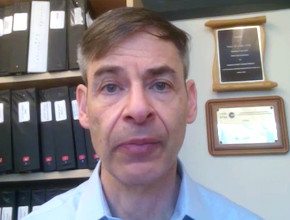Dr Waleed Alhazzani, associate professor in the Division of Critical Care at McMaster University, chair of Surviving Sepsis Campaign (SSC) guidelines, and lead author of the newest SSC guidelines focusing on coronavirus disease 2019 (COVID-19) in the critically ill, joins Dr Roman Jaeschke to review infection control and testing.
References
Alhazzani W, Møller MH, Arabi YM, et al. Surviving Sepsis Campaign: guidelines on the management of critically ill adults with Coronavirus Disease 2019 (COVID-19). Intensive Care Med. 2020 Mar 28. doi: 10.1007/s00134-020-06022-5. [Epub ahead of print] PubMed PMID: 32222812; PubMed Central PMCID: PMC7101866.For part 1 of this interview, click here. For part 3, click here.
Roman Jaeschke, MD, MSc: Good morning. Welcome to another edition of McMaster Perspective. It’s a pleasure to reintroduce Professor Waleed Alhazzani, the first author of the upcoming guidelines on caring for COVID-19 patients in the intensive care unit (ICU).
Could you tell us how this guideline is structured?
Waleed Alhazzani, MBBS, MSc: Thank you again for the invitation. This part of the guideline is focused on the individual management of patients and the health-care workers taking care of these patients.
We divided the guideline into 4 sections. The first section is on infection control and testing, so the precautions that health-care workers should be taking and which specimens should be sent. The second and third sections discuss ventilator support and hemodynamic support. The last section pertains to therapy, so direct therapy or other cointerventions from a pharmacologic point of view that could be applied to help support those patients.
Roman Jaeschke: They are all interesting, and I suspect changing every day. Why don’t we start from the beginning? Prevention and all that’s connected: gear, masks, specimens. Please share with us your recommendations. Maybe we’ll start with masks, where there’s lots of confusion even about the nomenclature that we’re using.
Waleed Alhazzani: Correct. It’s important to emphasize that we try to focus on, or prioritize, questions that are important for clinicians and health-care workers. For more detailed information about infection control in general, I would direct the readers to the websites of the World Health Organization (WHO) or the US Centers for Disease Control and Prevention (CDC) and also to follow their institution’s policy.
We looked at several important questions about which masks to use and what are the types of masks that are available. Generally speaking, there are the regular masks, sometimes called the medical or surgical masks; they mean the same thing. And there are the respirator masks, which are more expensive and prevent a higher percentage of particles from penetrating and entering into the respiratory system of the health-care providers or users. Those respirator masks are called different names, or they have different brands, in different geographic locations. In North America they’re known as N95 masks. In Europe and other parts of the world they may be known as filtering facepiece 2 (FFP2) masks. When we refer to these masks in the guideline, we say “fitted respirator masks.” This means they need to be fitted, so they need fit testing, and they are respirator masks—not the usual ones—or equivalent. You’ll see this common theme throughout the recommendations. I think it’s important to clarify this terminology before we dive into the recommendations.
Roman Jaeschke: The usual question that generated a lot of uncertainty was, “Which mask to use during which situations when caring for those patients, with either proven or strongly suspected COVID-19?”
Waleed Alhazzani: It’s a very important question. We tried as best as possible to base our recommendations on evidence. We would divide the scenarios into 2 situations. There’s a situation where there’s an aerosol-generating procedure being performed, or an aerosol-generating context in which a large number or volume of aerosol is generated, and obviously there’s a higher risk of infection. In this case airborne precaution is warranted. I’ll speak about that in a second.
The other scenario is when there’s no aerosol-generating procedure or context, so droplet precautions are the way to go.
For aerosol-generating procedures, we looked at the literature and recent systematic reviews that summarized the association between different procedures and the risk of disease transmission. We tried to be as objective as possible. But again, our list is not that different from other lists provided by the WHO or CDC.
Aerosol-generating procedures include endotracheal intubation; bronchoscopy or bronchoscopic interventions, in which the airways are open and you’re maneuvering; open suctioning; nebulized treatment; and manual bagging or ventilation before intubation.
There was one tricky part that I’d like to clarify, because I already had a couple of questions from colleagues, which is about the physical proning of patients. Proning itself is not an aerosolizing procedure. However, there is a higher risk of tube disconnection, and when that happens obviously it becomes a less controlled environment. So it’s put there just to caution people. In centers where they do proning very often and this is not a problem, they could simply ignore this part. However, in centers where they are new to proning, this may present a problem, and it’s wise to think about these issues.
Other aerosol-generating situations include any disconnection from the ventilator, which opens the communication between the patient’s airways and the environment; noninvasive positive pressure ventilation; tracheostomy; or cardiopulmonary resuscitation (CPR). So these are the situations where aerosol-generating procedures are performed, which means there is a higher risk of transmission of the disease.
Roman Jaeschke: Have you mentioned something about high-flow nasal cannulas?
Waleed Alhazzani: That’s an excellent question. Although the general feeling is that with some positive pressure being applied, it is a high-flow procedure, it may or may not generate aerosols. For this specific situation we say that you should follow your institution’s policy. Some colleagues have used masks, applied masks over patients who are receiving high-flow nasal cannulas. Whether this reduces the risk of transmission is unknown. We encourage people to follow their institution’s policy.
Roman Jaeschke: Do we know the policy in our institution [St Joseph’s Healthcare Hamilton]?
Waleed Alhazzani: For our institution, I don’t think high-flow nasal cannulas are considered an aerosol-generating procedure.
Roman Jaeschke: We’ll probably ask this question.
The second part of this guideline section considers which specimens to send. Could you comment on those?
Waleed Alhazzani: In the guideline we did not focus on, or did not address, patients outside the ICUs. We thought to focus on more challenging or at least less straightforward situations. There’s a lot of guidance out there on what to do if you have somebody with suspected COVID-19.
Having said that, let’s assume you have somebody who was intubated for respiratory failure. They’re suspected to have COVID-19. What specimens should you be sending? The questions that we looked at pertain to the site of sampling: upper versus lower airway. It seems that, at least from the very minimal studies out there, nasopharyngeal swabs cannot exclude the disease. Their sensitivity is not very high, although the specificity of the test is high. If the test result comes back positive, we’re almost certain the patient has the disease. But a nasopharyngeal swab that is negative with a high pretest probability still does not rule out COVID-19. So we say that in those scenarios where a patient is intubated, it may be worthwhile sending lower respiratory samples, with a caveat that bronchoscopy should be avoided unless it’s really needed. Bronchoscopy, as I mentioned, is an aerosol-generating procedure, so you always balance the benefits of having a higher yield sample versus exposing health-care workers to the risk. So we make a weak recommendation, or suggestion, to send endotracheal aspirates over nasopharyngeal swabs whenever possible.
Roman Jaeschke: So effectively you’re sending sputum specimens from lower airways?
Waleed Alhazzani: Correct.
Roman Jaeschke: And avoiding bronchoscopy is relevant. It’s a little disquieting that sensitivity is not that high, because it’s probably not any lower than in nonventilated people. Do we know what the sensitivity of swabs is?
Waleed Alhazzani: No. Hopefully as more evidence comes through, we’ll have a better idea about the diagnostic accuracy of the test.
Roman Jaeschke: Let’s wait then. That’s how we screened people, right? That’s how we investigate them outside. I hope it is in proximity of at least 80%, hopefully 90%, but if I hear correctly, we may not know this.
Let’s finish the first part here. I appreciate all the comments. It clarifies some questions, at least for me. We’ll talk about the other parts soon. Thank you very much.
 English
English
 Español
Español
 українська
українська











